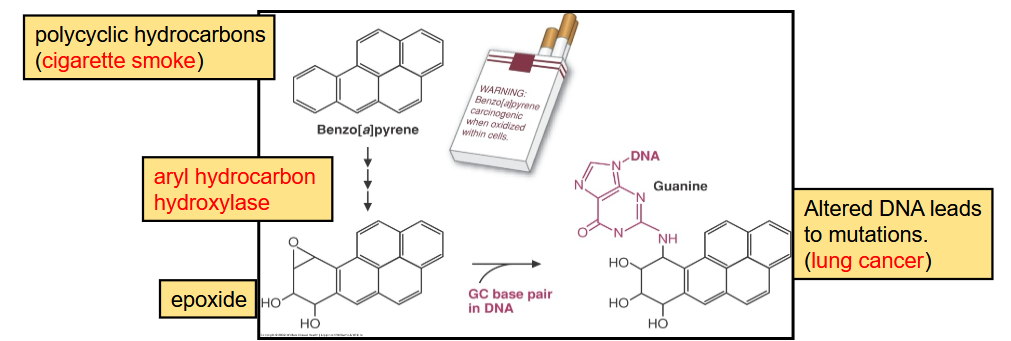Non-Mendelian and Multifactorial Inheritance
1/15
There's no tags or description
Looks like no tags are added yet.
Name | Mastery | Learn | Test | Matching | Spaced |
|---|
No study sessions yet.
16 Terms
What is Genomic Imprinting (where does it take place, what is generated, and what expressitivity?) Describe the mechanism of Genomic Imprinting in Chromosome 15
Take place in the germline
Initiated by imprinting center to generate non-coding RNA and chromatin change
TISSUE SPECIFIC
Imprinting of Chromosome 15
Paternal IC generate polycistronic RNA—> Silences Paternal gene of UBE3A
Maternal IC is silenced → expresion of UBE3A
Therefore, maternal UBE3A only expressed in neurons
Describe two diseases associated with genes dependent on Parential origin. Symptoms other causes of these disease?
Angleman:
Deletion in the maternal chromosome 15 → Loss of UBE3A function.
Symptoms:
intellectual disability
happy demeanor
balance disorder
speech impairment
Prader-Willi syndrome:
Deletion in the paternal chromosome 15 —> Loss of the polycistronic RNA or other genes.
Symptoms:
intellectual disability
obesity
short stature
hypogonadism (infertility)
Other causes:
Uniparental disomy
IC mutations
UBE3A or polycistronic RNA mutations
What is dynamic mutation? Where could this mutation occur? What is the premutation range? What is the theory on how this mutation occur?
Unstable trinucleotide repeat expansion: mutations where new
repeats occur in the next generation.*Could be in the promoter region, coding region, or affect splicing.
Premutation range : the range of repeats where individuals are unaffected but their offsprings are.
Theory:
Slipped mispairing → expansion occur during DNA replication or repair
Describe the pathology of Huntington’s Disease; Symptoms; What determines onset?
autosomal dominant neurodegenerative disorder; Neurological symptoms (chorea, dystonia, cognitive impairment).
CAG repeats in the huntingtin gene alter the function of the protein.
(larger number = earlier onset)
Describe the patholology of Fragile X Syndrome; Symptoms? Describe its expressitivity?
(X-linked dominant); causes X chromosome Condensation Defect;
Symptoms: moderate intellectual disability, large head, narrow face, large ears
Caused by excessive CGG repeats in Promotor of FMR1 gene —> Silencing; [FMR1 responsible for translational regulator in neurons]
(Expresivity is variable verses # of repeats; expressivity is lower in females)
Describe the patholology of Friedreich Ataxia; Symptoms?
(Autosomal recessive); Spinocerebellar ataxia (incoordination of limb movement, impairment of position and vibratory senses, speech impairment, scoliosis, cardiomyopathy).
Caused by excessive GAA repeats in intron of frataxin gene
(frataxin = Mit. protein involved in iron metabolism)
Mutation Impairs transcriptional elongation.
Why do mtDNA diseases have reduced penetrance and variable expression?
some cells might have more mutant mitochondrial DNA than others (randomly distributed)
Can be Homoplasmy (cell only contains mutant mtDNA) or Heteroplasmy (cell contains mitochondria with both normal and mutant DNA.)
expression of a disease phenotype depends on the ratio of the normal and mutant mtDNA.
Describe what mtDNA pedigree looks like; Example
Only females transmit the disease.
A heteroplasmic mother will pass the disease to all her children,
Example:
OXPHOS diseases such as Leber hereditary optic neuropathy
(NADH reductase deficiency) that causes optic atrophy, loss of vision.
what are multifactorial diseases? Describe how we would describe multifactoral disease? Why is there familiar Aggregation? What is the difference between concordant and discordant
caused by interaction between multiple genes and environmental factors. Genes associated = susceptibility genes
Qualitative trait: The individual either has the disease or not
Quantitative traits: Measurable parameters that associate with the diseaseFamiliar Aggregation: Diseases with multifactorial inheritance frequently cluster in families; Due to:
genetic material within the family
environment within the family
Concordant: 2 related individuals have the same disease
Discordant: 2 related individuals do not have the same disease
What is relative risk

What are the two types of twins and how can we use them to assess multifactorial diseases?
Monozygotic twins (MZ): identical genetic material
Dizygotic twins (DZ): 50% of their alleles in common
If:
<100% concordance between MZ = disease have environmental factor
If MZ concordance > DZ concordance = disease have a genetic component (especially true for early-onset diseases)
Venous Thrombosis: Describe what the disease is; susceptibility gene; and environmental factors
Excessive blood clot formation (e.g deep vein thrombosis)
Susceptibility genes: Factor V and prothrombin (gain-of-function mutations)
Environmental factors: oral contraceptives (OC, estrogen containing), smoking, prolonged inactivity, and trauma
Type I Diabetes Mellitus: Describe what the disease is; susceptibility gene; and environmental factors
Autoimmune destruction of pancreatic beta cells, which leads to insulin deficiency.
Susceptibility genes: certain major histocompatibility complex (MHC) loci (HLA-DR), that are responsible for producing cell surface proteins involved in antigen presentation.
Environmental factors: early viral infections or early exposure to cow’s milk.
Coronary Artery Disease: Describe what the disease is; susceptibility gene; and environmental factors
Formation of atherosclerotic plaques in arteries, that eventually can cause blood clot formation and myocardial infarction.
Susceptibility genes include different apolipoproteins, LDL receptor, coagulation factors, angiotensin converting enzyme, etc.
Many of these genes act through other multifactorial disorders such as hypertension, obesity, diabetes.
Environmental risk factors include diet, smoking, lack of physical activity.
Late-Onset Alzheimer’s Disease (Sporadic, Multifactorial Form): Describe what the disease is; susceptibility gene; and environmental factors
Caused by β-amyloid precipitation in the brain
Major susceptibility gene: Apolipoprotein E (ε4 isoform)
ApoE is present in the amyloid precipitates
Risk factors: age, sex (more frequent in females), brain injury
Lung Cancer: Describe what the disease is; susceptibility gene; and environmental factors
Environmental risk factor: cigarette smoke
Susceptibility genes: aryl hydrocarbon hydroxylase genes
Induced by cigarette smoke
Have high-inducibility and low-inducibility alleles
High-inducibility alleles produce more enzymes, which will generate more epoxides
